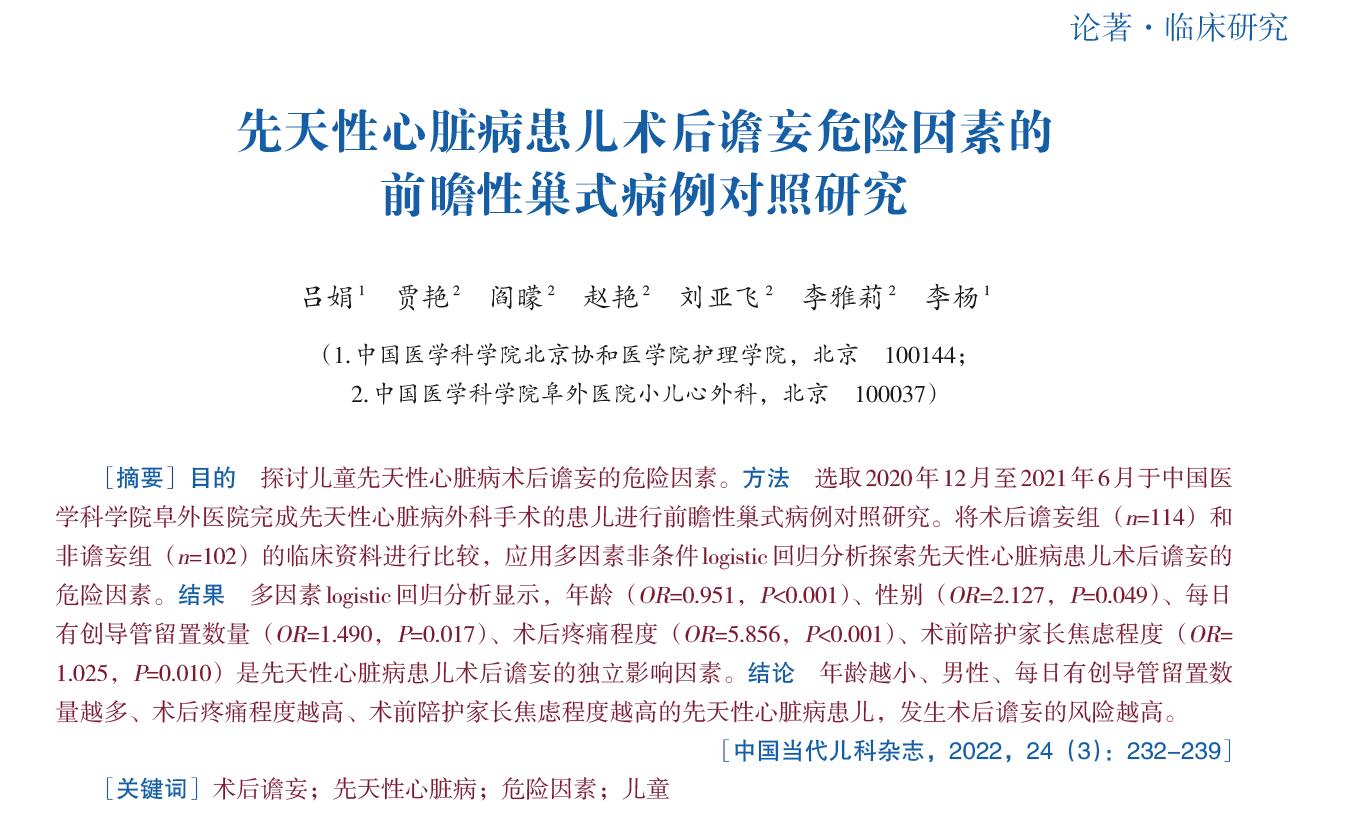 PDF(760 KB)
PDF(760 KB)


先天性心脏病患儿术后谵妄危险因素的前瞻性巢式病例对照研究
吕娟, 贾艳, 阎曚, 赵艳, 刘亚飞, 李雅莉, 李杨
中国当代儿科杂志 ›› 2022, Vol. 24 ›› Issue (3) : 232-239.
 PDF(760 KB)
PDF(760 KB)
 PDF(760 KB)
PDF(760 KB)
先天性心脏病患儿术后谵妄危险因素的前瞻性巢式病例对照研究
Risk factors for postoperative delirium in children with congenital heart disease: a prospective nested case-control study
目的 探讨儿童先天性心脏病术后谵妄的危险因素。 方法 选取2020年12月至2021年6月于中国医学科学院阜外医院完成先天性心脏病外科手术的患儿进行前瞻性巢式病例对照研究。将术后谵妄组(n=114)和非谵妄组(n=102)的临床资料进行比较,应用多因素非条件logistic回归分析探索先天性心脏病患儿术后谵妄的危险因素。 结果 多因素logistic回归分析显示,年龄(OR=0.951,P<0.001)、性别(OR=2.127,P=0.049)、每日有创导管留置数量(OR=1.490,P=0.017)、术后疼痛程度(OR=5.856,P<0.001)、术前陪护家长焦虑程度(OR=1.025,P=0.010)是先天性心脏病患儿术后谵妄的独立影响因素。 结论 年龄越小、男性、每日有创导管留置数量越多、术后疼痛程度越高、术前陪护家长焦虑程度越高的先天性心脏病患儿,发生术后谵妄的风险越高。
Objective To study the risk factors for postoperative delirium (POD) in children with congenital heart disease. Methods A prospective nested case-control study was performed on children with congenital heart disease who underwent surgery in Fuwai Hospital, Chinese Academy of Medical Sciences, from December 2020 to June 2021. The clinical data were compared between the POD group (n=114) and non-POD group (n=102). A multivariate unconditional logistic regression analysis was used to investigate the risk factors for POD in children with congenital heart disease. Results The multivariate logistic regression analysis showed that age (OR=0.951, P<0.001), gender (OR=2.127, P=0.049), number of invasive catheters per day (OR=1.490, P=0.017), degree of postoperative pain (OR=5.856, P<0.001), and preoperative parental anxiety level (OR=1.025, P=0.010) were independent risk factors for POD in children with congenital heart disease. Conclusions The risk of POD increases in children with congenital heart disease who are younger, male, have higher number of invasive catheters per day, higher degree of postoperative pain, or higher preoperative parental anxiety level.

Postoperative delirium / Congenital heart disease / Risk factor / Child
1 李烁琳, 顾若漪, 黄国英. 儿童先天性心脏病流行病学特征[J]. 中国实用儿科杂志, 2017, 32(11): 871-875. DOI: 10.19538/j.ek2017110617.
2 中华人民共和国国家卫生健康委员会妇幼健康司. 中国妇幼健康事业发展报告(2019)[EB/OL]. (2019-05-27)[2021-09-09]. http://www.nhc.gov.cn/fys/jdt/201905/bbd8e2134a7e47958c5c9ef032e1dfa2.shtml.
3 郑鸿. 不同治疗方式对先天性心脏病患儿生存质量的影响[J]. 护理研究, 2016, 30(3): 340-342. DOI: 10.3969/j.issn.1009-6493.2016.03.027.
4 Ma XJ, Huang GY. Current status of screening, diagnosis, and treatment of neonatal congenital heart disease in China[J]. World J Pediatr, 2018,14(4):313-314. PMID: 30066048. DOI: 10.1007/s12519-018-0174-2.
5 Patel AK, Biagas KV, Clarke EC, et al. Delirium in children after cardiac bypass surgery[J]. Pediatr Crit Care Med, 2017, 18(2): 165-171. PMID: 27977539. PMCID: PMC5658045. DOI: 10.1097/PCC.0000000000001032.
6 Alvarez RV, Palmer C, Czaja AS, et al. Delirium is a common and early finding in patients in the pediatric cardiac intensive care unit[J]. J Pediatr, 2018, 195: 206-212. PMID: 29395177. DOI: 10.1016/j.jpeds.2017.11.064.
7 庄英, 段霞, 宋瑞梅, 等. 心脏术后谵妄早期识别影响因素的研究进展[J]. 护理学杂志, 2017, 32(14): 15-18. DOI: 10.3870/j.issn.1001-4152.2017.14.015.
8 Leroy PL, Schieveld JNM. Mind the heart: delirium in children following cardiac surgery for congenital heart disease[J]. Pediatr Crit Care Med, 2017, 18(2): 196-198. PMID: 28157798. DOI: 10.1097/PCC.0000000000001038.
9 金丕焕, 陈峰. 医用统计方法[M]. 3版. 上海: 复旦大学出版社, 2009: 269-273.
10 Silver G, Traube C, Kearney J, et al. Detecting pediatric delirium: development of a rapid observational assessment tool[J]. Intensive Care Med, 2012, 38(6): 1025-1031. PMID: 22407142. DOI: 10.1007/s00134-012-2518-z.
11 何珊, 王亚力, 左泽兰. 中文版康奈尔儿童谵妄量表的临床初 步应用[J]. 中华儿科杂志, 2019, 57(5): 344-349. DOI:10.3760/cma.j.issn.0578-1310.2019.05.006.
12 Traube C, Silver G, Gerber LM, et al. Delirium and mortality in critically ill children: epidemiology and outcomes of pediatric delirium[J]. Crit Care Med, 2017, 45(5): 891-898. PMID: 28288026. PMCID: PMC5392157. DOI: 10.1097/CCM.0000000000002324.
13 Krechel SW, Bildner J. CRIES: a new neonatal postoperative pain measurement score. Initial testing of validity and reliability[J]. Paediatr Anaesth, 1995, 5(1): 53-61. PMID: 8521311. DOI: 10.1111/j.1460-9592.1995.tb00242.x.
14 Merkel SI, Voepel-Lewis T, Shayevitz JR, et al. The FLACC: a behavioral scale for scoring postoperative pain in young children[J]. Pediatr Nurs, 1997, 23(3): 293-297. PMID: 9220806.
15 Slater A, Shann F, ANZICS Paediatric Study Group. The suitability of the pediatric index of mortality (PIM), PIM2, the pediatric risk of mortality (PRISM), and PRISM III for monitoring the quality of pediatric intensive care in Australia and New Zealand[J]. Pediatr Crit Care Med, 2004, 5(5): 447-454. PMID: 15329160. DOI: 10.1097/01.PCC.0000138557.31831.65.
16 Jenkins KJ, Gauvreau K, Newburger JW, et al. Consensus-based method for risk adjustment for surgery for congenital heart disease[J]. J Thorac Cardiovasc Surg, 2002, 123(1): 110-118. PMID: 11782764. DOI: 10.1067/mtc.2002.119064.
17 World Health Organization. Stunting, wasting, overweight and underweight[EB/OL]. [2021-08-21]. https://apps.who.int/nutrition/landscape/help.aspx?menu=0&helpid=391&lang=EN.
18 杨梅, 林彬, 赵南义. 临床医技讲义[M]. 贵阳: 贵州科技出版社, 2016: 59.
19 汪向东, 王希林, 马弘. 心理卫生评定量表手册[M]. 增订版. 北京: 中国心理卫生杂志社, 1999.
20 张鑫杰. 改良耶鲁术前焦虑量表的汉化及信效度评价[D]. 大连: 大连医科大学, 2018.
21 Aldecoa C, Bettelli G, Bilotta F, et al. European Society of Anaesthesiology evidence-based and consensus-based guideline on postoperative delirium[J]. Eur J Anaesthesiol, 2017, 34(4): 192-214. PMID: 28187050. DOI: 10.1097/EJA.0000000000000594.
22 Harris J, Ramelet AS, van Dijk M, et al. Clinical recommendations for pain, sedation, withdrawal and delirium assessment in critically ill infants and children: an ESPNIC position statement for healthcare professionals[J]. Intensive Care Med, 2016, 42(6): 972-986. PMID: 27084344. PMCID: PMC4846705. DOI: 10.1007/s00134-016-4344-1.
23 高华炜, 陈求名, 赵韡, 等. 三种先天性心脏病手术风险评分系统预测效能的比较[J]. 中华心血管病杂志, 2019, 47(5): 388-392. PMID: 31142083. DOI: 10.3760/cma.j.issn.0253-3758.2019.05.010.
24 Meyburg J, Dill ML, von Haken R, et al. Risk factors for the development of postoperative delirium in pediatric intensive care patients[J]. Pediatr Crit Care Med, 2018, 19(10): e514-e521. PMID: 30059477. DOI: 10.1097/PCC.0000000000001681.
25 Kain ZN, Caldwell-Andrews AA, Maranets I, et al. Preoperative anxiety and emergence delirium and postoperative maladaptive behaviors[J]. Anesth Analg, 2004, 99(6): 1648-1654. PMID: 15562048.DOI: 10.1213/01.ANE.0000136471.36680.97.
26 Bryant KJ. Pediatric delirium in the cardiac intensive care unit: identification and intervention[J]. Crit Care Nurse, 2018, 38(4): e1-e7. PMID: 30068726. DOI: 10.4037/ccn2018947.
27 Meyburg J, Dill ML, Traube C, et al. Patterns of postoperative delirium in children[J]. Pediatr Crit Care Med, 2017, 18(2): 128-133. PMID: 27776085. DOI: 10.1097/PCC.0000000000000993.
28 Fan H, Ji M, Huang J, et al. Development and validation of a dynamic delirium prediction rule in patients admitted to the Intensive Care Units (DYNAMIC-ICU): a prospective cohort study[J]. Int J Nurs Stud, 2019,93:64-73. PMID: 30861455. DOI:10.1016/j.ijnurstu.2018.10.008.
29 庄璇. 成人心脏瓣膜置换术后谵妄风险因素分析及风险评估体系的构建[D]. 青岛: 青岛大学, 2020.
30 刘书婷, 王寿勇. 小儿全身麻醉苏醒期谵妄的研究进展[J]. 重庆医学, 2015, 44(35): 5035-5037. DOI: 10.3969/j.issn.1671-8348.2015.35.048.
31 Maclullich AMJ, Ferguson KJ, Miller T, et al. Unravelling the pathophysiology of delirium: a focus on the role of aberrant stress responses[J]. J Psychosom Res, 2008, 65(3): 229-238. PMID: 18707945. PMCID: PMC4311661. DOI: 10.1016/j.jpsychores.2008.05.019.
32 黄云, 韩霞, 付会敏. 舒适化镇静镇痛在先心术后小儿谵妄护理中的应用效果[J]. 现代医药卫生, 2021, 37(13): 2293-2295. DOI: 10.3969/j.issn.1009-5519.2021.13.038.
33 Ong C, Han WM, Wong JJM, et al. Nutrition biomarkers and clinical outcomes in critically ill children: a critical appraisal of the literature[J]. Clin Nutr, 2014, 33(2): 191-197. PMID: 24423748. DOI: 10.1016/j.clnu.2013.12.010.